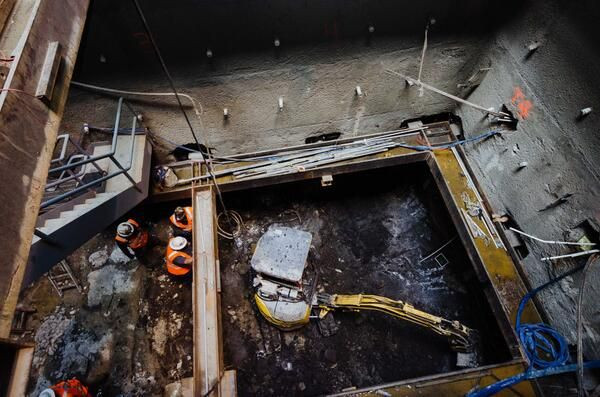Treasure Trove Of Fossils Unearthed In L.A. Subway Construction Across The Street From La Brea Tar Pits

Construction is underway for a subway extension in Los Angeles but the location is no ordinary worksite as paleontologists are working to recover fossils that date back 300,000 to two million years.
Geoduck clams unearthed in Purple Line exploratory shaft near Fairfax/Wilshire, which is no longer under ocean. pic.twitter.com/e2Iq9zqQU7
— Metro Los Angeles (@metrolosangeles) March 6, 2014An exploratory shaft was constructed at Wilshire Boulevard, in front of the Los Angeles County Museum of Art, and across the street from the La Brea Tar Pits, reports the Los Angeles Times. The shaft, which goes to a depth of 65 feet, was to be used to examine soil conditions for future excavations as construction for the subway extension will begin in 2015.
The Los Angeles County Metropolitan Transportation Authority is working with the Page Museum at the La Brea Tar Pits and the LACMA to ensure the fossil record in the area is preserved. Kim Scott, Director of Paleontology for Cogstone Resource Management, has been leading the project which to date has unearthed fossilized geoducks, sand dollars, digger pine tree cones and seeds as well as rock which could hold a two million-year-old sea lion skull.
Compared to the fossils found at the La Brea Tar Pits, the newly-discovered fossils are much older and reveal an ancient beach and a time when an ocean covered Los Angeles, reports SCPR. The fossils also indicate a cooler climate during the Pleistocene epoch. Speaking to SCPR, Scott said the recovered fossils will be cleaned, cataloged and then sent to the Natural History Museum of LA County.
Some of the fossils collected thus far from Purple Line Ext exploratory shaft. Most thought to be 300k or so yrs old. pic.twitter.com/D7tPvsSLxZ
— Metro Los Angeles (@metrolosangeles) March 6, 2014When the Wilshire/Fairfax subway stop construction begins next year, paleontologists will be working alongside construction workers to preserve any fossils. When LACMA began construction on an underground parking lot in 2006 led to the discovery of 23 new fossil deposits were discovered. Instead of painstakingly excavating each deposit, which would also lead to long delays in construction, Project 23, as it is known, boxed up each of the deposits. The boundaries of each deposit were identified and wooden boxes were built and the deposits were transported away from the construction site. LA Times reports a similar process will be used for any fossil discoveries in the upcoming construction project.
© Copyright IBTimes 2025. All rights reserved.






















